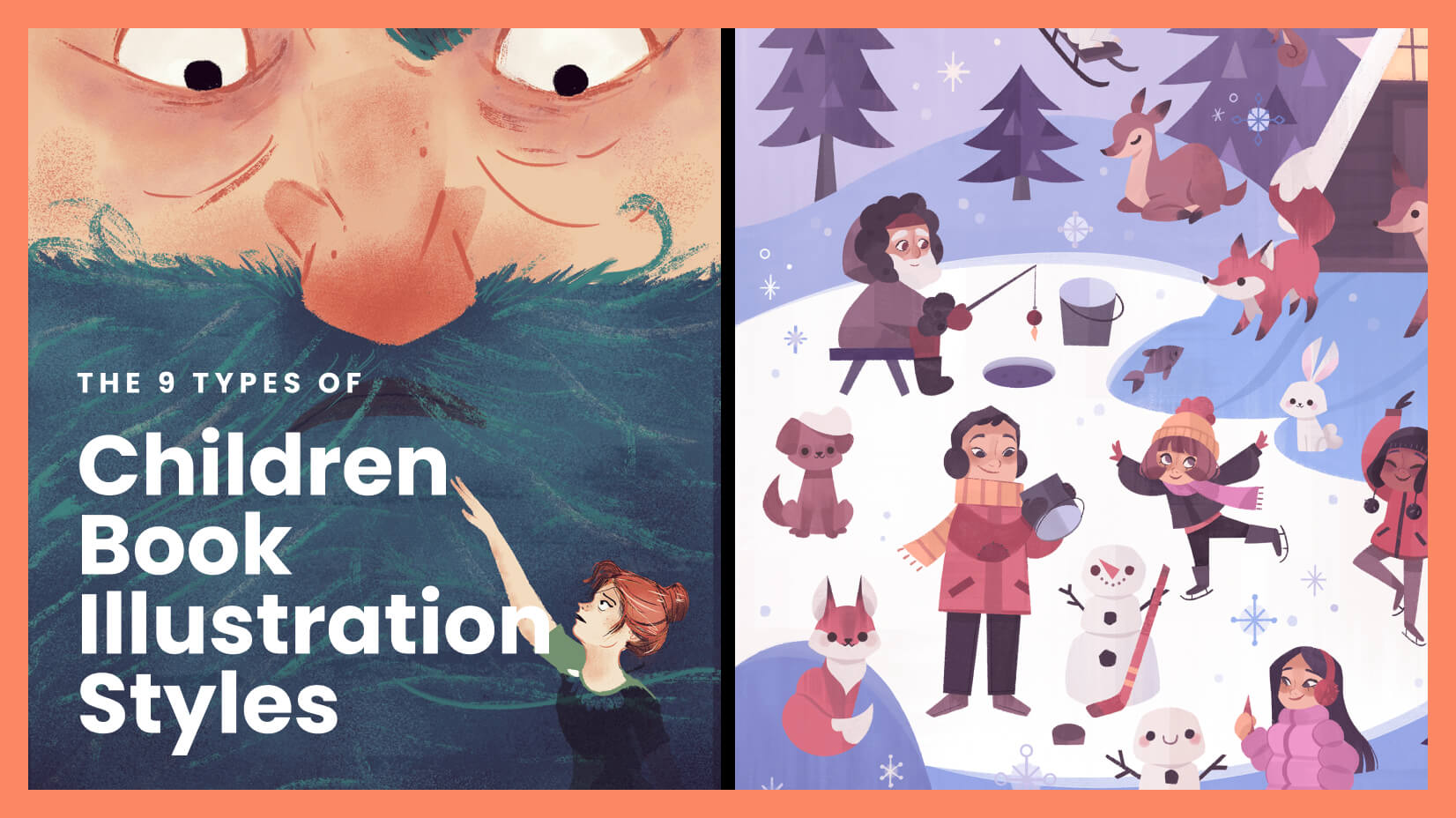
Crafting children’s books involves five essential components. Firstly, creativity sparks ideas and births stories. Authors then meticulously weave narratives that captivate and inspire young readers. Publishing and marketing come next, sharing the story with the world. However, it’s children book illustration styles that steal the spotlight, visually guiding the narrative and demanding artistic flair. Successful children’s books are like puzzles, with each piece vital. Illustrations, among these, breathe life into the narrative, capturing young hearts.
Reach GraphicMama Studio for custom children’s book illustrations.
When it comes to choosing a children book illustration style, consider these key points:
- Understand Your Story: Dive into your story’s core themes and emotions, and select an illustration style that enhances them.
- Know Your Audience: Tailor the style to your target age group, whether colorful and whimsical for young readers or intricate for older ones.
- Set the Tone: Ensure the chosen style aligns with your narrative’s mood, be it playful or contemplative.
- Explore Styles: Familiarize yourself with prevalent illustration styles, from watercolor to digital art, and choose the one that resonates.
- Collaborate: Partner with an illustrator whose style aligns with your vision, enhancing your story’s essence.
With this perspective, let’s explore contemporary Children’s Book Illustration Styles that enrich these beloved tales. Dive into captivating visuals that breathe life into stories cherished by both the young and young at heart.
Article Overview:
1. Cartoon Style Illustrations
Cartoon-style illustrations, known for their vibrant and engaging visuals, are one of the most common styles in children’s books. This style isn’t just about using bright colors and characters resembling those from Disney; it takes it a step further by giving animals human qualities and adding some exaggeration to make the visuals more captivating.
These illustrations are famous for their exaggerated features, moving away from strict realism. This style actually covers a wide range of variations, including some other illustration styles. In simpler terms, we can divide cartoons into two main styles, with the first one being the “cute” or “childlike” version. This style is commonly seen in children’s books, especially those for younger readers. It aims to connect with the innocence and sense of wonder in childhood.
– Best Suited for: Whimsical Adventures
Cartoon-style illustrations work exceptionally well for playful adventures and stories aimed at young children. They are great at capturing young imaginations and sparking a sense of wonder. These illustrations create a visual world that mirrors the innocence of childhood, making them perfect for stories about friendship, exploration, and exciting adventures. Whether it’s a mischievous animal character exploring a colorful world or a group of endearing characters discovering a vibrant landscape, cartoon-style illustrations bring in charm and playfulness, enhancing the reading experience for young readers.
– Examples of Cartoon Illustrations for Children’s Books
With that being said, let’s explore a curated selection of children’s book illustrations in a lively and captivating cartoon style. These hand-picked examples showcase the artistry and imagination that bring stories to life for young readers. Join us in this visual journey as we delve into the world of playful characters, whimsical adventures, and the magic of cartoon-style illustrations.
2. Realistic Illustration Style
In children’s books, the term “Realistic Illustration Style” means something specific. It’s not hyper-realistic but aims to portray things somewhat like they appear in real life. This sets it apart from the exaggerated, playful style often seen in children’s books. Realistic illustrations in children’s books can be simple or very detailed. While a few children’s books use actual photos, this style isn’t common.
Still, some artists specialize in this more true-to-life style. They sometimes blend it with other styles to create something special. The examples below show how this realistic yet stylized method combines authenticity and artistic skill.
– Perfect for: Learning and True Stories
The Realistic Illustration Style works best in children’s books that focus on teaching or telling true stories. Its attention to realistic proportions and details makes it great for explaining facts and showing historical figures or real-life situations accurately. These illustrations shine in books meant to help kids learn about the world, nature, and history. Whether it’s a science book about nature’s wonders or a biography of a famous person, the Realistic Illustration Style adds depth and truth to the story, making it a superb choice for educational and true stories.
– Examples of Realistic Illustrations for Children’s Books
See how the realistic style adds an authentic touch to the pages, making the reading experience richer for curious young minds. These chosen examples reveal the artistry and precision that bring educational tales and true stories alive for young readers.
3. Wimmelbuch Style
Wimmelbuch originates from Germany and you can easily recognize this style by the densely packed, highly detailed scenes teeming with characters, objects, and activities. Unlike traditional illustrations that follow a single narrative or focal point, Wimmelbuch illustrations invite readers to explore and discover a multitude of stories happening simultaneously within a single frame.
These pictures are packed with things to discover, making them exciting for young readers. They help kids learn and have fun at the same time. Wimmelbuch pictures are so popular because they make children curious, encourage them to play, and make them feel close to the story. To create a Wimmelbuch picture, an artist carefully plans and adds lots of things to the scene. This makes readers want to explore and find new things in the busy picture.
– Ideal for: Curious Kids
The Wimmelbuch Style is great for children’s books that are meant for curious kids who love to explore. These pictures work well for young readers and toddlers. They help kids learn new words, recognize things, and tell stories. Wimmelbuch pictures make reading fun and exciting. Whether it’s a bustling city, a zoo full of animals, or a magical forest, Wimmelbuch-style pictures let children discover and enjoy a world of wonder. This makes them a wonderful choice for early learning and fun reading.
– Examples of Wimmelbuch Illustrations:
Now, let’s explore some Wimmelbuch examples that transport us into richly detailed and bustling worlds. These illustrations are like treasure maps, inviting us to uncover hidden stories in every corner.
4. Whimsical Illustrations Style
Whimsical illustrations, also known as fantasy or whimsical artwork, offer a delightful and charming style that awakens childlike wonder. These illustrations are carefree, dreamy, and filled with lively, colorful details. Unlike realistic art, whimsical illustrations care more about sparking imagination than showing reality. They transport us to magical worlds where everyday things become extraordinary, igniting our imagination’s boundless possibilities.
– Ideal for: Bedtime Stories and Fairy Tales
The Whimsical Illustration Style is a perfect fit for children’s books crafted for bedtime tales and fairy stories. Its captivating, dreamy qualities draw in young readers, welcoming them into enchanting realms where anything can happen. These illustrations set the stage for magical adventures, making them a great choice for stories featuring talking animals, enchanted forests, and mythical creatures. Whether it’s a classic fairy tale or an original bedtime story, whimsical illustrations sprinkle a bit of magic, enriching the storytelling experience. They transport children to a world where imagination takes the lead, making them a superb choice for creating cherished childhood memories.
– Examples of Whimsical Illustrations in Children’s Books:
Here we have inspirational examples of enchanting whimsical illustrations in children’s books. All are filled with charm, imagination, and vibrant colors that paint playful and dreamy worlds.
5. Abstract Illustration Style
Abstract illustrations in children’s books are something else. Unlike realistic art, this style focuses on shapes, colors, and patterns instead of showing detailed pictures of real things. They encourage young readers to interpret and explore the story in their own creative ways which inspires artistic thinking and provides a blank canvas for children’s imaginations to flourish.
– Perfect for: Igniting Creativity and Imagination
These illustrations, with their emphasis on shapes, colors, and patterns, excel in stories that encourage kids to think differently. They work exceptionally well in books that explore abstract concepts, emotions, or unconventional adventures. They’re an ideal match for stories that celebrate the diverse and boundless creativity of young minds.
– Examples of Abstract Illustrations:
Let’s take a look at some creative examples that bring abstract art to life in the pages of children’s books.
6. Moody Illustrations
Moody illustrations in children’s books create a captivating atmosphere through the use of muted tones, high contrast, and a deliberate choice of shapes and colors. These illustrations have a unique ability to convey a wide range of emotions and feelings, from the melancholic to the cozy and homely. Unlike other styles, moody illustrations rely on the interplay of light and shadow to set the emotional tone of the story.
– Ideal for: Capturing Complex Emotions and Atmosphere
Great to use in children’s books that aim to create immersive atmospheres. These illustrations, with their muted tones and careful use of light and shadow, are a perfect fit for stories that delve into deeper feelings, whether it’s the bittersweet nostalgia of a coming-of-age tale, the comforting warmth of a family story, or the mysterious intrigue of an adventure.
– Examples of Atmospheric Illustrations:
Let’s delve into some ambiance as we explore a collection of moody illustrations in children’s books. These illustrations employ colors, shapes, and shadows to convey feelings and create a particular atmosphere.
7. Line Drawing and Sketch Style
Line drawing and sketch-style illustrations use clean lines, and minimal details, and often stick to black and white or a few colors to convey stories and feelings. They can range from playful and whimsical to deeply touching and thought-provoking. This style lets your imagination fill in the gaps, making it a captivating choice for all kinds of stories. Taking things literally, line drawings are the go-to for coloring books where you can fill them with your own colors and create your own atmosphere.
– Great for: Unleashing Imagination and Feelings
Line drawings and sketch-style illustrations work well in stories that explore strong feelings, like the thrill of an adventure, the warmth of a touching moment, or the wonder of a magical encounter. And of course, this style is absolutely best for coloring books.
– Examples of Line Illustrations and Sketches in Children’s Books:
Here we have some more inspiration with line illustrations and sketches in children’s books. These drawings focus on simplicity and expression, leaving room for your imagination to play a part in the story.
8. Vintage Style Illustrations
Vintage-style drawings evoke the charm of bygone days, embracing a classic and enduring look. With their warm, muted colors and intricate details, they can create a cozy and familiar feeling. They transport young readers to a world where tradition meets imagination.
– Ideal for: Connecting Generations and Timeless Tales
Vintage illustrations are perfect for children’s books that aim to connect generations and tell timeless stories. These drawings, with their classic and enduring charm, are a great fit for stories that celebrate tradition and nostalgia. They transport young readers to a world that blends the past and present, helping them feel a connection to their parents’ and grandparents’ stories.
– Examples of Vintage Children’s book illustrations:
And last, let’s enjoy a couple of vintage illustrations in children’s books. These classic drawings can instalty transport us to a time filled with nostalgia and enduring charm.
9. Manga Style Illustrations
Manga-style illustrations, respectively, refer to Japanese manga/ comics and anime industry. Of course, a lot of manga is created for children as well, so we’ll include that style. With their bold lines, expressive characters, and dramatic storytelling, manga-style illustrations offer a unique and engaging experience for young readers, mostly in the shape of a comic book.
– Ideal for: Adventure and Graphic Storytelling
A fantastic choice for children’s books with action-packed stories where the character’s emotions and actions are vividly depicted on the page. This style is trendy among older children and young adults, making it also a great choice for graphic novels and stories that require a more mature and dynamic visual approach.
– Examples of Manga Children’s Book Illustrations:
Let’s look at some manga books made for children. With captivating characters and dynamic illustrations, they give younger readers a touch of action and a dash of intrigue.
What Makes a Good Children’s Book Illustration?
As illustrations are key to grabbing kids’ attention and making stories even better, they need to have certain qualities. Here’s what to consider when planning the artwork for a children’s book:
- Engagement: Good illustrations grab a child’s attention, pulling them into the story and igniting their curiosity about the book.
- Complementarity: They enhance the text, working alongside the story rather than overshadowing it. Illustrations should harmonize with the narrative, reinforcing its themes and emotions.
- Age Appropriateness: Illustrations should suit the book’s target age group, connecting with the stage of development and interests of young readers.
- Clarity: Clear storytelling is crucial. Illustrations should effectively convey the story’s message, helping young readers understand and connect with the plot.
- Imagination: Encouraging children’s imagination is key. The best illustrations leave space for interpretation, allowing kids to explore and develop their creativity.
- Emotion: Exceptional illustrations evoke feelings. They make readers laugh, cry, wonder, and empathize with the characters, creating memorable reading experiences.
- Cohesiveness: Illustrations should maintain a consistent style throughout the book, ensuring a visually unified reading experience.
- Details: Attention to detail breathes life into a story. Whether it’s creating intricate settings in a fantasy tale or capturing lifelike expressions on characters’ faces, details matter.
- Accessibility: Good illustrations are accessible to all readers, including those with visual impairments. Inclusivity is essential in modern children’s literature.
- Endurance: Outstanding illustrations stand the test of time, becoming timeless classics that continue to captivate generations of young readers.
These qualities combine to create illustrations that not only enrich a children’s book but also leave a lasting impact on young minds, nurturing their love for reading and storytelling.
Where to Find a Children’s Book Illustrator
Finding the right illustrator for your children’s book is a crucial step in bringing your story to life. Fortunately, there are various avenues you can explore to discover talented illustrators. Here are a few options to consider:
Hire an Agency
Choosing an agency for your children’s book illustrations has its advantages. Agencies offer access to a variety of skilled illustrators and ensure a professional touch. Project management is typically included, reducing your workload. However, it’s important to note that agencies can be more expensive than hiring an independent illustrator. Direct communication with the artist may be limited, and the process may take longer due to their workload. Deciding on an agency should be based on your budget and preferred level of creative involvement.
For custom children’s book illustrations, consider GraphicMama. We create tailored artwork, ensuring your project’s unique vision is brought to life. Whether you need a specific style, character design, or story-aligned illustrations, we have your back.
Hire a Freelancer
Hiring a freelancer for your children’s book illustration project offers several advantages. Freelancers often provide cost-effective solutions, allowing you to work within your budget. You have the flexibility to select an illustrator whose style aligns perfectly with your vision, and direct communication with the illustrator ensures that your creative input is heard and implemented efficiently.
However, there are potential downsides to consider. Freelancers may have limited availability, leading to longer project timelines, and quality can vary based on the individual’s expertise. Additionally, managing the project and ensuring consistency across illustrations may require more hands-on involvement on your part. It’s crucial to thoroughly vet freelancers and establish clear terms and expectations to mitigate these challenges.
Here are some platforms where you can find amazing freelance artists:
- Fiverr: Fiverr connects authors with freelance illustrators. You can browse various styles and work directly with freelancers. It’s budget-friendly and flexible.
- Reedsy: Reedsy caters to authors and publishers, curating professional illustrators, including those specializing in children’s books. Browse portfolios, request quotes, and find the right fit.
- Behance: Behance is a creative platform where artists and designers showcase their work. Explore a variety of styles to discover an illustrator that aligns with your project.
Final Words
We’ve explored a range of illustration styles, each bringing its own unique charm to the world of children’s stories. From playful cartoons to lifelike realism, these illustrations enrich storytelling, leaving a lasting impact on children.
Cartoon illustrations ignite childhood wonder, realistic styles educate and inspire, Wimmelbuch designs encourage exploration, whimsical illustrations create enchanting bedtime tales, and abstract styles foster artistic thinking. Moody illustrations stir emotions, while vintage artwork bridges the past and present.
In the pages of children’s books, illustrations are more than just pictures; they’re companions on adventures, sparks for imagination, and conveyors of timeless wisdom. Whether through simple line drawings or nostalgic artwork, these illustrations are beacons of creativity and connection.
In the meantime, why not get some more insights and inspiration by visiting some of the following articles:

























































































